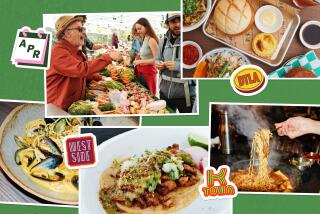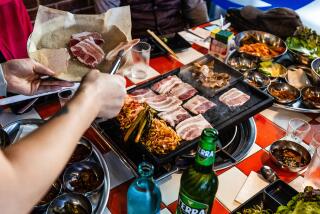Foodie nation
ONCE, I was sent $5 by a reader miffed that I’d left a Los Angeles taco stand off a list of my favorites. Because the amount wasn’t large enough to consider pocketing, I sent it back, but it was a reminder of the passions that can arise around food. Whether discussing tacos, pizza or barbecue, we as a nation go at it with a zeal that matches the French in the matter of rillons versus rillettes.
But do we write with such passion? Would we even want such convictions captured in the written form? After all, bubbling beneath them is pride in one’s neighborhood, city and state, qualities that make for a great bragging smack-down, but not necessarily for good reading. Yet that same fervor is the essence of good food writing.
These days, food writing is a genre unto itself. It is taught, anthologized and critiqued. Perhaps it was only a matter of time before a definitive collection was attempted -- and “American Food Writing: An Anthology With Classic Recipes” is it. Published by the Library of America and edited by former New York Times food columnist Molly O’Neill, this volume is more than an anthology; selection builds upon selection (from Thomas Jefferson’s recipe for ice cream to Michael Pollan’s musings on the organic frozen dinner) to become a portrait of a nation seen through the prism of food. Culinarily, it links the potted lobster of the early 19th century with the tuna burger of today’s bistro; socially, it traces a line from the pioneer experience to the immigrant one. At its broadest, the book reveals our shifting approach to nature as it moves from the confidence with which we once claimed its bounty to our more uneasy times.
The trick to marshaling all this into a coherent form is to edit without editorializing, to set a framework within which the multidirectional topic can prosper and stretch. I rather wish that O’Neill had at least given a nod to why the many recipes in the book should be considered food writing. After all, most of the elements by which we judge good writing are, necessarily, absent from a list of ingredients and steps. Do the recipes illuminate a greater subject or trend? The lack of explanation tends to get one’s back up about the absence from the collection of one’s own favorite authors. For example, why should Marcella Hazan’s recipe for risotta alla parmigiana be included but nothing from Eudora Welty’s paean to her hometown, “The Flavor of Jackson”?
In the introduction, O’Neill establishes the broad lines the book follows: “Whether implicit or explicit, the tension between the civilized and the wild is a constant in American food writing. It expresses itself in various binary oppositions: between refined and rough, elite and democratic, professional and amateur, expensive and affordable, foreign and home-grown.”
Early on, that conflict seems to be a contrast between immediacy and “sedate gentility.” George G. Foster paints the six-penny eating houses of 1840s New York, where waiters stood in doorways braying, “Rosebeefrosegoorosemuttonantaters ... walkinsirtakaseatsir” at passersby. Frederick Douglass describes how slaves, who didn’t get to eat breakfast or dinner in their quarters, cooked their ash cakes in the fields: “The surface of this peculiar bread is covered with ashes, to the depth of a sixteenth part of an inch, and the ashes, certainly, do not make it very grateful to the teeth, nor render it very palatable.”
Social reformer Henry Ward Beecher’s 1862 description of apple pie is surely the standard against which all others must be measured. The dessert, he wrote, “will accept almost every flavor of every spice. And yet nothing is so fatal to the rare and higher graces of apple-pie as inconsiderate, vulgar spicing. It is not meant to be a mere vehicle for the exhibition of these spices, in their own natures. It is a glorious unity in which sugar gives up its nature as sugar, and butter ceases to be butter, and each flavorsome spice gladly evanishes from its own full nature, that all of them, by a common death, may rise into the new life of apple-pie!”
When the writing lacks this immediacy it has a grating top-down tone. Not to put too fine a point on this, but ladies who had time to write about food did not have to cook. “Probably the delicate cotelettes of France are not flopped down into half-melted grease, there to gradually warm and soak and fizzle, while [the cook] goes in and out on her other ministrations,” writes Beecher’s sister, the novelist Harriet Beecher Stowe. One even bristles at such memories as those of food columnist Elizabeth Robins Pennell, writing for a London newspaper in 1896: “Fried chicken! To write the word is to be carried back to the sunny South; to see, in the mind’s eye, the old, black, fat, smiling mammie, in gorgeous bandana turban, and the little black piccaninnies bringing in relays of hot muffins. Oh, the happy days of the long ago!” Indeed.
Though the demarcations are arbitrary, there is something like a middle era when the tension revolves around the nascent symbolism of food. In Edna Ferber’s short story “Maymeys From Cuba,” published in 1912, a long and expertly rendered sequence follows an impoverished young woman gazing at a Chicago importer’s midwinter tropical fruit display to her eventual collapse on the floor of a bustling department store. “When your last meal is an eighteen-hour-old memory, and when that memory has only near-coffee and a roll to dwell on, there is something in the sight of January peaches and great strawberries carelessly spilling out of a tipped box ... that is apt to carve sharp lines in the corner of the face.”
As strong as this is, there is something equally convincing in the opposing bemused tone -- and vantage point, in which symbolism is called on the carpet and nostalgia isn’t given an inch. In the 1940s, humorist S.J. Perelman deems the menu of an L.A. soda fountain “an attractively printed job in two colors (three if you count the gravy),” and author Betty MacDonald sends a big Bronx cheer to that symbol of homesteading: “Canning is a mental quirk just like any other form of hoarding. First you plant too much of everything in the garden; then you waste hours and hours in the boiling sun cultivating; then you buy a pressure cooker and can too much of everything so that it won’t be wasted.”
By the third -- and current -- section of the book, food has taken on its full symbolism. Ray Gonzalez’s ode to menudo and Shirley Geok-lin Lim’s memories of boiled chicken feet indicate the extent to which food has become the great conveyor of identity. The pungent social observation, the affecting moment linking generations, all seem to come alive in proximity to a stove and a few simmering pots. While O’Neill advances these themes, she also makes room for a broader exploration of food ethics, cleverly pinging between pieces by Alice Waters, she of Chez Panisse, and Ray Kroc, he of McDonald’s. But as the contributors become contemporaries of O’Neill, the variety of voices narrows -- no more journals or letters -- and consequently, the effervescence of the earlier sections seems diminished. To read chef Anthony Bourdain and writers Eric Schlosser, Ruth Reichl and Pollan in quick succession gives the impression that the search for material ended at the first bestseller bin at Barnes & Noble.
Still, the challenge has been met; the passion for food is expressed in written form. Where it is lacking, say in Nora Ephron’s dated essay on the food world or David Sedaris’ glib assessment of a gourmet meal, vitality is momentarily halted. But that passion is quickly revived, whether in John Thorne’s essay on the Toll House cookie, Betty Fussell writing about the suburban drinking bouts that passed for cooking classes or Corby Kummer describing the “beautiful pale straw color, and the sweet, nutty overtones” that make a Vermont Shepherd cheese unique. All are examples of the compressed emotions that go into the best food writing, and the effortless way with which authors have long carried that freight.
More to Read
Eat your way across L.A.
Get our weekly Tasting Notes newsletter for reviews, news and more.
You may occasionally receive promotional content from the Los Angeles Times.






